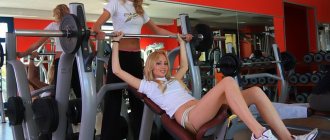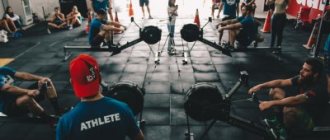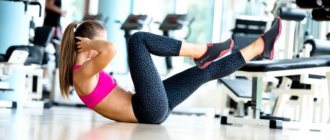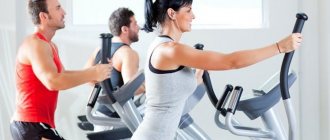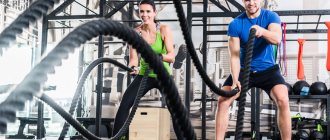Stair running is an alternative training option if for some reason it is not possible to run outside or in an arena. What qualities does this type of running develop, what are its advantages and how to run up the stairs correctly so as not to harm yourself, read in this article.
Do you want to train in the cold season with the same pleasure and dedication as in the summer? – Is this possible, or are amateur runners, every year with the onset of the cold and snowy season, doomed to sadly reduce their running volumes, deny themselves speed work if there is no accessible athletics arena at hand, and wait for spring?
Among the usual recommendations on how to survive the off-season, the most common one is to focus on general physical fitness and strength training. But this doesn’t always work: some people immediately reject the idea of regularly going to the gym, some try it and as soon as they get bored, they give up training - still, to be honest, most of us, amateur runners, are not very -what he likes to do – in a group and as a team, under the supervision of a coach, no matter what. What can we say about at least partially replacing running with general physical training.
You can look for different alternatives: from cross-training to completely changing sneakers to skis for the winter. But what if you still want to keep running? And so that it is varied: both intensive and developing, and without the fear of getting sick? Here it’s time to remember Rocky Balboa, from whom, in addition to discipline and obsession with the training process, you can definitely borrow stair running as a type of training.
On the subject: How to replace running: 13 alternative options
What does running up stairs do?
The positive effects of stair running as a plyometric, strength and aerobic exercise are clear. Like plyometrics, running on stairs strengthens the same muscle groups as lunges and squats, pumping our ligaments and tendons, preventing injury.
In the form of a strength complex, it gives the runner not only speed and power, but also technicality and economy of running, activates stabilizer muscles and often those muscles that should take part in the running process, but for some reason do not work. It also has a pronounced effect on the functioning of our cardiorespiratory system and makes us more resilient.
Training plans for marathon and half marathon. and start preparing today.
Here the steps can be compared to running up a good hill, because the slope of the steps indoors is usually much greater than any of the hills or rises that you will find in the area, so running up the stairs will also help in preparing for trails.
In addition, in the off-season, one should not miss the fact that running up stairs allows you to burn calories very well, so if you want to stay dry and fit, monitor your weight during the winter season, then this may be another reason to include running in your workout. stepping stones into your workouts.
Benefits of Stair Running
Running on stairs has now been well studied in the scientific literature, and if you want to find out more facts confirming the benefits of steps in the training process, it will not be difficult. Here are just a few of them.
A study published in BMJ Open Diabetes Research & Care shows that vigorous walking up and down stairs for 3 minutes, some time after eating, leads to lower blood sugar levels in subjects with type 2 diabetes.
The British Journal of Sports Medicine reports that even small additions of stair running 5 times a week for 8 weeks lead to a 17% increase in VO2 max.
And running on steps for 10 minutes 3 times a week after 6 weeks gives a significant increase in general functional indicators - heart rate, recovery time, breathing rate, exercise tolerance - according to the journal Medicine & Science in Sports & Exercise.
There are even studies that show that 10 minutes of stair training can invigorate and give you more energy and strength than a mug of coffee. Researchers from Georgia University found that the effects of the steps were greater than those of 50 mg of caffeine.
And if you suddenly get carried away by the process of running up the stairs, then there is an international association of fans of running into skyscrapers - Towerrunning World Association. Their website presents an entire world tour of the planet's largest skyscrapers, from the Empire State Building (a climb to the 86th floor with 1,576 steps) to the skyscrapers of China, Mexico, Great Britain, the Netherlands, Estonia and Croatia. Participants have ratings, qualifying and final races - in general, excellent competitive motivation.
And in Russia now they already have their own high-altitude races, you can practice at home.
Recommendations
In short, the reasons are very compelling to consider incorporating this type of training into your routine. But where to start preparing? And how can you include running up stairs in your training process as gently and correctly as possible? Although running up the stairs seems easy, it has its pitfalls, so at the initial stage it is better to follow the general recommendations:
1. Be sure to do a good warm-up before you start running up the stairs. This can be a light jog outside to warm up and then a joint warm-up, consisting of basic exercises: rotations, bends, swings, outlines, lifts on the foot and rolls - in place and in motion. Spend 10 minutes on this, and always start the first steps of the stairs by walking, not running, so you will prepare the body to more gently accept the load.
2. During training, monitor the position of your head and body, stay straight, look in front of you, and not down at your feet.
3. Add load gradually, start with walking and running/walking switches, and only then move on to running to the 14-20th floor.
4. Keep the duration of training on the stairs no more than 20-30 minutes.
5. Include stair running as separate workouts in your plan once a week or add small blocks to an existing training plan depending on the nature of the activity: in the form of a strength complex, developmental exercises or high-intensity interval running.
6. Don't forget about foot recovery. 30-minute workouts on concrete staircases can be quite a significant load. Therefore, after such exercises, it will be useful to do exercises for your toes, roll your feet with a ball and do a light massage.
What muscles work when walking up stairs?
It is important to know which muscles are affected by walking when climbing stairs.
This process involves the following muscle groups:
- straightening knees,
- hamstrings,
- gluteal muscle,
- foot games.
Therefore, this type of training is suitable for those who want to strengthen the leg muscles, get rid of fat deposits on the hips, and also make the buttocks more elastic.
Training on the stairs will replace visiting the gym. The principle of operation of many simulators, as well as exercises, is based on the process of climbing and descending stairs.
Running up the stairs. Training plan
What might your stair workout look like? Let's look at a few examples.
Day 1
Type: ORU (developmental exercises)
Training. After a 10-minute warm-up, we choose 1 flight of stairs, 10 steps, perform the exercise up, and go down easily by running.
We practice the following exercises:
- easy calm running – “1 leg 1 step”;
- fast technical running – “1 leg 1 step”;
- “running through 1 step” - repeat 2 times;
- “climbing” (someone may need to hold onto railings or walls) through 2 steps - repeat 2 times;
- “running with one side” / “running with the other side”;
- easy calm running – “1 leg 1 step”.
If you wish and have time (and good condition of your legs), this short complex can be done in 3-4-5 approaches, several times a week. In terms of time, it will take you on average from 1.5 to 5-6 minutes.
Day 2
Type: walking/running
Training. After a 10-minute warm-up, we work in the following format: 1 flight of stairs (10 steps) walking, the next flight (10 steps) – intense running. To begin with, you can use the average number of floors of a house of 10-14 floors: up in walking/running mode for 2-3 minutes, 4-5 minutes - lightly jogging down. Do 4-5 approaches.
In the future, increase the number of approaches, bringing the total duration of the workout to 30 minutes. You can also vary not only the number of approaches, but also the duration of the runs. Once you have mastered running 1 flight, you can try switching “running 2 flights/walking 2 flights”, “running 3 flights/walking 3 flights” and, if necessary, add intensity: “running 2 flights/walking 1 flight, running 3 flights” /walk 1 flight.”
Day 3
Type: running + strength training
Training. After a 10-minute warm-up, we choose 2-4 flights of stairs, which you will run up for a while, and at the top do one of the strength exercises of your choice: push-ups, squats, jumping out of the bottom squat, and lightly jog down. A 30-minute workout is best divided into several sets, each of which will consist of 3-4 repetitions, and between them 1-2 minutes of pure rest.
Day 4
Type: Plyometric and Strength Exercises
Training. After a 10-minute warm-up, you can use the stairs as a gym for your actual strength training.
What can you do from general physical training on the steps? Below is a list of exercises that should be performed on the spot before a flight of stairs for 10 to 20 repetitions.
- Stepping onto the step, bringing the leg up to the high hip.
- Step onto the steps, lift your leg into a high hip position, and when returning to the starting position, lunge back.
- Jumping on the steps with your feet one at a time, spread out your feet.
- Jumping onto the steps with both feet from a standing position, and on one foot from a standing position.
- Standing on your hands from the steps, do the “climber” exercise.
- Also, while standing up from the steps, do regular and reverse push-ups.
- Lunge through a few steps. Statics (stand in a lunge and freeze for 20 seconds).
In dynamics, as plyometrics, you can perform the “Skater” exercise on the stairs, as well as jumping on both legs and one leg directly/sideways into the steps.
Day 5
Type: running
Training. After a 10-minute warm-up, you run up to the top floor at a steady, comfortable pace. It is better to start with high-rise buildings no more than 10-14 floors. You time your run up, run away with a light jog, or go downstairs with active walking (also time your time). Based on the time spent, gradually increase the length of the workout, bringing it to 30 minutes.
Don’t forget about recovery after running up the stairs and that after an intense workout, it’s better to do the next session in the recovery format: run actively up the stairs, then run at a slow and calm easy run. With the right planning, stair running can be a great way to vary your winter workouts and make you stronger, faster and more resilient.
Exercises on the stairs for weight loss
It's warmer, which means you can go from the stuffy gym to the park or stadium. Stairs are perfect for outdoor fitness. Such activities will help diversify your sports life and work individual muscles. This is an easy way to make your legs slim and your buttocks firm. Moreover, everyone can master the exercises on the stairs!
If you complain that you live too high and prefer an elevator, then you can make the usual exercise of climbing stairs a fitness exercise. Exercises can be performed not only on the street, but also in the entrance. The ladder is a great exercise machine that you don’t have to pay for. It is always “under your feet”, and to start, you only need desire. So why not turn your daily walk up flights of stairs into an effective workout?
Benefits of classes
Stair walking is a whole sport that began its existence thanks to the Japanese scientist Yoshiro Hatano, who invented the electronic pedometer. These days, this activity is gaining more and more popularity, and this is not surprising, because it benefits the body.
- Exercises with stairs improve heart function. Walking stairs every day will help strengthen your cardiovascular system and also reduce the possibility of a stroke or heart attack.
- Exercises strengthen the muscles of the legs and buttocks. During the exercises, the calves and thighs are involved, which helps to work out their relief. The butt is also tightened.
- Climbing stairs every day helps you lose weight. While walking, your calorie expenditure increases. For one intensive workout of 30 minutes. it is possible to lose up to 700 kcal!
- With the help of exercises, the muscles of the legs, back and abs are strengthened.
- Regular exercise helps cope with respiratory diseases. As a result, the lungs develop and shortness of breath disappears.
- Constant exercise maintains tone in the body and improves mood.
Thus, exercises on steps are an alternative to working out in the gym. Exercising not only helps you lose weight and get toned, but also improves your health.
Harm and contraindications
Exercising on the stairs in the entrance and on the street brings great benefits to both the body and the body. However, it is not recommended for everyone as a health maintenance activity. Some will still have to give them up.
Exercise can be harmful. For example, pain in the heart may occur due to heavy exertion. Dizziness, shortness of breath and darkening of the eyes are signs that there is a problem. In this case, you should stop the activity or slow down the pace.
Also, pain in the joints causes the cessation of exercise on the stairs. If you constantly feel pain and discomfort from exercise, stop exercising and consult your doctor.
But there are conditions when athletics on the stairs is completely contraindicated for people. Avoid training if you have:
- scoliosis;
- joint damage (knee and hip);
- disruption of the heart and blood vessels;
- phlebeurysm;
- poor eyesight.
Restrictions also apply to pregnant girls. Intense gymnastics during this period is contraindicated. Exercising with stairs can also be dangerous because it is easy to injure limbs, especially ankles.
Top exercises on steps for a beautiful body
The complex that we will tell you about will help pump up your legs and butt, making you irresistible!
These exercises really work, the main thing is to do them regularly.
“Staircase” - one step at a time
This is a classic exercise that does not require special preparation and has no technical nuances. To perform it, take the starting position:
- stand next to the stairs;
- keep your arms bent near your body;
- Direct your gaze towards the steps so that you don’t stumble while doing the exercise.
Class technology:
- Step up each step as you go up.
- Step on the front of your foot, not the whole of it.
- Bend and straighten your legs at the knee joint, this causes movement.
- If you want to transfer the load to your calves, then work more actively with your ankles and slower with your knees. The pace increases.
The classic method is good for warming up. It does not work the muscles much, but maintains their tone. This exercise is also suitable for strengthening the heart.
If it’s hard for you, then don’t run up the stairs, reduce the load and move at an average pace.
Walking lunges
The workout is reminiscent of classic lunges, only here they are done by lifting the body up the stairs.
Technical part:
- Stand in front of the step, step forward with one foot 2-3 ledges.
- Lower the knee of your free leg as low as possible, the leading one should not extend beyond the toe.
- Gradually increase the depth of descent.
- Try to put your weight on your supporting heel to take the pressure off your knees.
This step exercise helps to work your leg muscles and create a round butt.
Long jump
Bouncing on stairs is a simple exercise that helps build endurance and coordination. There is such a technique:
- Place your feet shoulder-width apart in a half squat.
- Jump to the top step, bringing your arms forward. This helps you jump further and maintain your balance.
- Land softly on the balls of your feet.
- To make it easy to jump, pull your body up with the strength of your legs and abs. To do this, tense your abdominal muscles and pull them towards your ribs.
To make it easier to understand the technique, some trainers suggest imitating a frog jump.
Burpee
Involves all muscles of the body. Includes 2 elements - plank and push-up. The work involves not only the hips and buttocks, but also the arms, abs, and back muscles. A ladder will help you perform an easier version of burpee.
- Stand in front of the step, resting your hands on the ledge, take a plank position without jumping.
- One at a time, pull your legs towards your chest, bending your knees, and rise up.
- Try to do the exercise at a fast pace.
The higher the step, the easier it is to do burpees. You can use a chair or nightstand to practice.
Side squat
Do you want to work your gluteal muscle as best as possible? Then this method is for you:
- Stand sideways to the stairs.
- Take a wide step to the side, one step at a time.
- Lower your pelvis while performing a squat. Keep your legs parallel to each other.
- Make sure that your knees do not extend beyond your toes; keep them bent at a 90-degree angle.
- Perform the exercise by pulling your body forward.
- Repeat the workout on the other leg.
Smoothness is important during class. There is no need to jump when pushing off the step.
Squat Raise
This butt exercise on the stairs looks quite comical. But this does not make it any less effective.
- Face the steps with your feet shoulder-width apart.
- Sit down and rise in this position.
- Maintain a 90 degree angle at your knees.
- Walk up the stairs, alternating your legs and without lifting your pelvis.
- Keep your back straight, slightly moving forward. Try to fix the body in one position.
- Hands in front of you.
- Make sure your socks don't go beyond your knees.
- Do not swing during the exercise.
Lifting on fingers
Do you dream of slender legs? Then we recommend working your calf muscles. To do this you will need to do a simple exercise:
- Turn around to face the stairs, keep your arms along your body.
- Step onto the step, leaving your toes on the support and your heels in the air.
- Rise up on your toes 4 times, making springy movements.
- At the same time, bend the other leg at the knee.
- Alternate limbs as you perform lifts.
The higher you raise your heels, the better the muscles are worked.
Sprint
This workout is technically simple, but it will require endurance and speed.
- The task is simple - climb the stairs as fast as you can.
- While running, tilt your body slightly forward and push off with your fingertips.
- Use your hands.
Be careful when doing this. Accelerate to the best of your ability.
Running with high hips
This activity will require you to go at a fast pace, which will help burn calories.
- Stand facing the stairs.
- Step on each step, bringing your hip as high as you can.
- Help yourself with your hands, actively work with them, holding them close to your body.
- Perform the exercise carefully, gradually increasing the lift of your leg.
The ideal complex for the buttocks
If your goal is a toned butt, then do the exercises we described above. Squats on stairs, lunges and jumps are great for working your buttocks. Running will help keep not only your butt toned, but also your legs.
Do the exercise on the stairs for weight loss in the warm season. If you like to run in the park, then do exercises with steps afterwards. This complex replaces cardio training and helps burn calories quickly.
To be more prepared, you can find other training options on the Internet, where many photos and videos of training are provided.
Sample charging plan
In order to maintain body tone, it is enough to exercise 2-3 times a week. Both morning and evening are suitable for classes.
Before training, be sure to warm up. To do this, choose to run up the stairs. Easy jog of 5-10 minutes. warms up the body. Also stretch all your joints. Do some exercises for your arms, neck and legs. After this you can start charging:
- Start with a side squat.
- Then do lunges on the stairs.
- The next step will be a squat rise.
- Then do long jumps.
- Finish your exercise with a finger lift.
Such a small complex will help a beginner begin to work out his legs and butt. Each exercise is done 2-3 times. If heavy, shorten the workout by performing one set. If you are used to loads, then feel free to add additional elements.
Start training your body now, and in a month you will see the first results.
Video training
Tips for conducting classes
- Choose exercises that suit you. If you feel bad during a class, then it is not for you.
- Consider the load. If you are new to sports, then do not try to jump over your head. Start small, 15 minutes. in the first days they will bear fruit. Gradually increase the time and pace of your workouts.
- Carefully read the section with contraindications; it is possible that exercise on the stairs is not suitable for you.
- Don't forget, success depends on the regularity of your studies. Don't give up on training.
- Also, immediately before the complex you need to do a warm-up.
- To lose weight, it is important to follow a proper diet. Healthy food will help you model a beautiful body.
Where to spend
Finding the stairs is not difficult. It's ideal if you go for a walk because the parks have a great atmosphere for exercising and there are plenty of steps.
If you can’t go outside, then feel free to run up the stairs right in the entrance. The main thing is not to scare your neighbors.
A multi-story building is good for running. Skip the elevator and feel free to go up to the apartment on your own.
Reviews of exercises on the stairs
I decided to work on my figure and started running.
In spring and summer I like to train outdoors, mainly with a jump rope or on a wall. I recently discovered exercises with stairs, which helped work out the muscles of my legs and butt. I'm happy with the result and continue to practice. I gained weight over the winter, so I began to actively lose weight. To quickly get back into shape, I started eating properly and discovered an alternative to home workouts: training with stairs. In cold weather, I ran along the passages in the entrance, and with warmth I went outside. This complex helps me burn calories quickly. I saw my favorite fitness blogger doing exercises on the stairs. I wanted to try it too. I started doing running warm-ups, doing various squats and jumps. To my surprise, within 1 month my achievements began to be noticed. The main thing is regularity. The ladder is a free exercise machine for all muscle groups that anyone can use. If you want to lose weight and work out your relief, then feel free to try exercises on the steps. This complex helps burn calories and get a slim figure. Do not forget about constant loads and correct technique, and then success will await you.
How would you rate this material?


